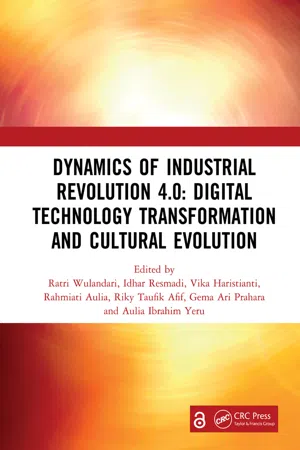
Dynamics of Industrial Revolution 4.0: Digital Technology Transformation and Cultural Evolution
Proceedings of the 7th Bandung Creative Movement International Conference on Creative Industries (7th BCM 2020), Bandung, Indonesia, 12th November 2020
- 368 pages
- English
- ePUB (mobile friendly)
- Available on iOS & Android
Dynamics of Industrial Revolution 4.0: Digital Technology Transformation and Cultural Evolution
Proceedings of the 7th Bandung Creative Movement International Conference on Creative Industries (7th BCM 2020), Bandung, Indonesia, 12th November 2020
About This Book
The 7th Bandung Creative Movement conference presented the theme "Dynamics of Industrial Revolution 4.0" which discussed how the digital world and connectivity changed human culture in various aspects of life, and transformed in accordance to human needs and social culture. Digital technology has transformed society to serve peoplefrommanufacturing needs to smart cities, from network connectivity to people connectivity. The application of information technology has helped in improving live quality and environmental sustainability. Digital transformation is revolutionizing how businesses and workers interconnect to be more productive and efficient. The result is improved collaboration, faster processes and time-to-market, lower costs and better products. Devices are getting smarter, meaning they are able to perform more and more tasks without human intervention; moreover, these devices generate data that provide insights to further improve processes and gain greater efficiencies. Moreover, with the Internet of Things (IoT), all these smart devices are interconnected in ways that not only help make them even smarter, but also enhances the intelligence of the overall system. Digital technology is a formidable driver for the transformation of a highly carbon-dependent world into one that is more ecologically 'smart.' We are entering a new era of environmental innovation that is driving better alignment between technology and environmental goals. Since its first announcement in 2011, industrial revolution 4.0 has dynamically changed and transformed to adjust itself to the human needs and to serve more efficiency and effectiveness of everyday life as well as environmental enhancement. The7th Bandung Creative Movement has brought forward discussions on dynamic changes, ups and downs, innovations, relations of industrial revolution of the internet of thing, data, automation, to human physical world, new art and aesthetic, business, product innovation, built environment, and education.
Frequently asked questions
Information
Innovation of products, creative industries management and marketing
Opportunities for the utilization of natural fiber fabrics in home living textile products with the “back to nature” lifestyle trend
1 Introduction
2 Methodology And Discussion
- Literature or review that is used in books, scientific journals, internet media, and others that discuss the merger of fashion with art, fashion with textile craft design, engineering, and mood board concepts in fashion and business start-ups.
- Observations relating to the work that was inspired were carried out by conducting a survey.
- Experimental methods are carried out by exploration using a variety of informal techniques, with mix materials in existing media.

| No | Brand | Materials | Technique | Price Range |
|---|---|---|---|---|
1 | Bermock | Acrylic & Polyester | Woven | IDR 600.000 –IDR 800.000 |
2 | Naratisa | Canvas & Blacu | Pattern Making & Digital Printing | IDR 60.000 –IDR 200.000 |

Table of contents
- Cover
- Half Title
- Title Page
- Copyright Page
- Table of Contents
- Preface
- The 7th Bandung Creative Movement International Conference
- Keynote and Featured speakers
- Creative technology, data, and creative industry
- Digital transformation of environment
- Digital technology transformation and cultural evolution in time of pandemic
- Innovation of products, creative industries management and marketing
- Aesthetic evolution in digital era
- Digital education for creative industries
- Digital technology and cultural evolution